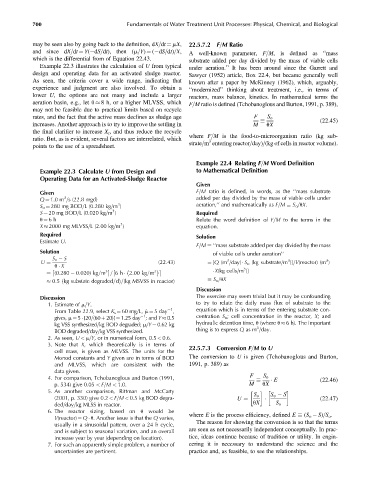Page 745 - Fundamentals of Water Treatment Unit Processes : Physical, Chemical, and Biological
P. 745
700 Fundamentals of Water Treatment Unit Processes: Physical, Chemical, and Biological
may be seen also by going back to the definition, dX=dt ¼ mX, 22.5.7.2 F=M Ratio
and since dX=dt ¼ Y( dS=dt), then (m=Y) ¼ ( dS=dt)=X, Awell-knownparameter, F=M,is defined as ‘‘mass
which is the differential from of Equation 22.43. substrate added per day divided by the mass of viable cells
Example 22.3 illustrates the calculation of U from typical under aeration.’’ It has been around since the Garrett and
design and operating data for an activated sludge reactor. Sawyer (1952) article, Box 22.4, but became generally well
As seen, the criteria cover a wide range, indicating that known after a paper by McKinney (1962), which, arguably,
experience and judgment are also involved. To obtain a ‘‘modernized’’ thinking about treatment, i.e., in terms of
lower U, the options are not many and include a larger reactors, mass balance, kinetics. In mathematical terms the
aeration basin, e.g., let u 8 h, or a higher MLVSS, which F=M ratio is defined (Tchobanoglous and Burton, 1991, p. 389),
may not be feasible due to practical limits based on recycle
rates, and the fact that the active mass declines as sludge age F S o
(22:45)
increases. Another approach is to try to improve the settling in M uX
the final clarifier to increase X r , and thus reduce the recycle
where F=M is the food-to-microorganism ratio (kg sub-
ratio. But, as is evident, several factors are interrelated, which
3
strate=m entering reactor=day)=(kg of cells in reactor volume).
points to the use of a spreadsheet.
Example 22.4 Relating F=M Word Definition
Example 22.3 Calculate U from Design and to Mathematical Definition
Operating Data for an Activated-Sludge Reactor
Given
Given F=M ratio is defined, in words, as the ‘‘mass substrate
3
Q ¼ 1.0 m =s (22.8 mgd) added per day divided by the mass of viable cells under
3
S o ¼ 280 mg BOD=L (0.280 kg=m ) aeration,’’ and mathematically as F=M S o =uX.
3
S ¼ 20 mg BOD=L (0.020 kg=m ) Required
u ¼ 6h Relate the word definition of F=M to the terms in the
3
X 2000 mg MLVSS=L (2.00 kg=m ) equation.
Required Solution
Estimate U.
F=M ‘‘mass substrate added per day divided by the mass
Solution
of viable cells under aeration’’
S o S 3 3 3
(22:43) ¼ [Q (m =day) S o (kg substrate=m )]=V(reactor) (m )
u X
U
3
3 3 X(kg cells=m )]
¼ (0:280 0:020) kg=m = 6h 2:00 kg=m
0:5 kg substate degraded=dÞ=(kg MSVSS in reactor) S o =uX
ð
Discussion
Discussion The exercise may seem trivial but it may be confounding
1. Estimate of m=Y. to try to relate the daily mass flux of substrate to the
1
From Table 22.9, select K s ¼ 60 mg=L, ^m ¼ 5 day , equation which is in terms of the entering substrate con-
1
gives, m¼ 5 [20=(60þ 20)]¼ 1.25 day ;and Y 0.5 centration S o ; cell concentration in the reactor, X; and
kg VSS synthesized=kg BOD degraded; m=Y¼ 0.62 kg hydraulic detention time, u (where u 6 h). The important
3
BOD degraded=day=kg VSS synthesized. thing is to express Q as m =day.
2. As seen, U < m=Y, or in numerical form, 0.5 < 0.6.
3. Note that X, which theoretically is in terms of
cell mass, is given as MLVSS. The units for the 22.5.7.3 Conversion F=M to U
Monod constants and Y given are in terms of BOD The conversion to U is given (Tchobanoglous and Burton,
and MLVSS, which are consistent with the 1991, p. 389) as
data given.
4. For comparison, Tchobanoglous and Burton (1991, F S o E (22:46)
p. 534) give 0.05 < F=M < 1.0. M uX
5. As another comparison, Rittman and McCarty
S o S o S
(2001, p. 330) give 0.2 < F=M < 0.5 kg BOD degra- (22:47)
U ¼
ded=day=kg MLSS in reactor. uX S o
6. The reactor sizing, based on u would be
V(reactor) ¼ Q u. Another issue is that the Q varies, where E is the process efficiency, defined E (S o S)=S o .
usually in a sinusoidal pattern, over a 24 h cycle, The reason for showing the conversion is so that the terms
and is subject to seasonal variation, and an overall are seen as not necessarily independent conceptually. In prac-
increase year by year (depending on location). tice, ideas continue because of tradition or utility. In engin-
7. For such an apparently simple problem, a number of eering it is necessary to understand the science and the
uncertainties are pertinent. practice and, as feasible, to see the relationships.

